Full Length Research Paper
ABSTRACT
Suspended sediments samples were collected from ten different locations through the Subansiri River to assess heavy metals contamination such as Fe, Al, Ti, Pb, Zn, Cu, Ni, Co, Mn and Cr. The enrichment factor (EF), contamination factor (CF), geo-accumulation index (Igeo) and pollution load index (PLI) were investigated for evaluate metal contamination in the sediments. The relative distribution of major minerals such as quartz, feldspar (orthoclase and microcline) and kaolinite are determined by calculating extinction co-efficient. The mean concentration exhibits positive correlations among Fe, Al, Ti, Mn, Zn, Pb, Ni, and Co. The relative distributions of the contamination are: Al > Ti > Fe > Mn > Cu > Cr > Zn > Pb > Ni > Co. The investigating factors suggest the significant contamination for Subansiri river sediments are Cu and Pb. The mean concentrations of heavy metals in the sediments were found to be below the geochemical background level of world surface rock average. The elemental correlation is indicative to the metamorphosed pyrophanite (MnTiO3) deposition. The infrared analysis indicates presence of micro-crystalline quartz particles and weathered metamorphous silicate minerals.
Key words: Heavy metals, suspended sediments, pollution.
INTRODUCTION
MATERIALS AND METHODS

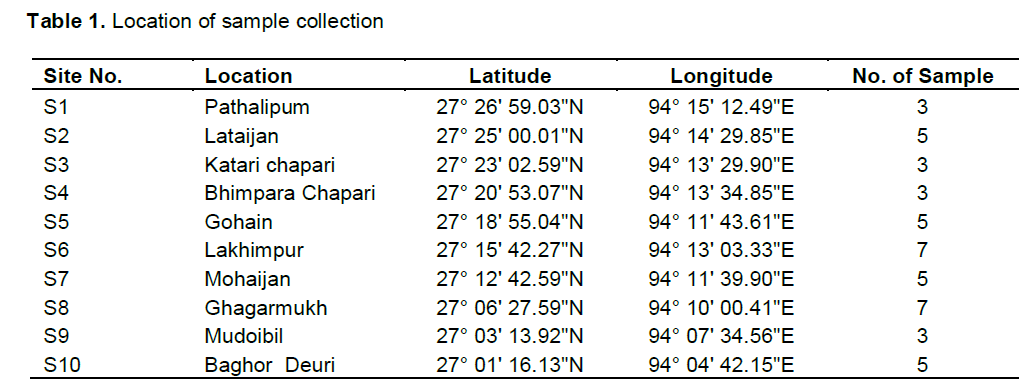

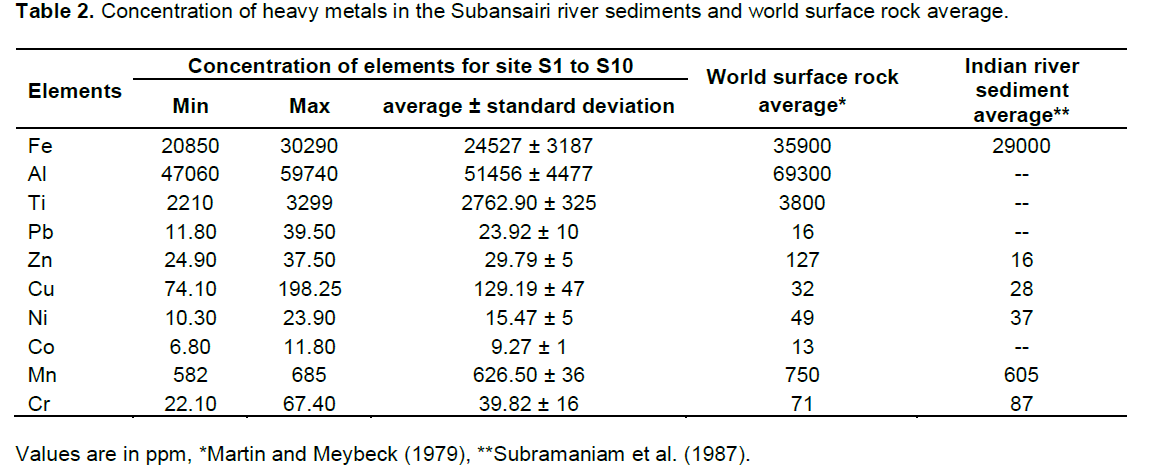




RESULTS AND DISCUSSION
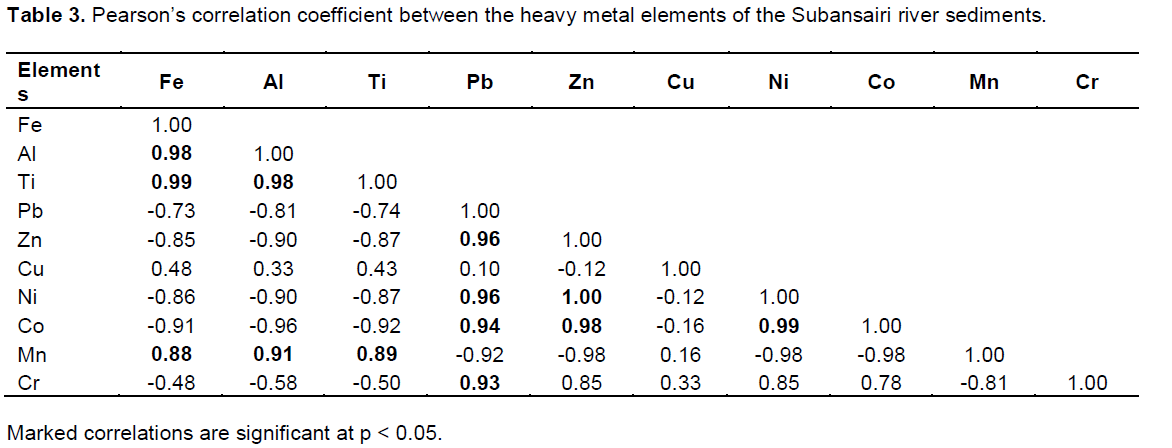
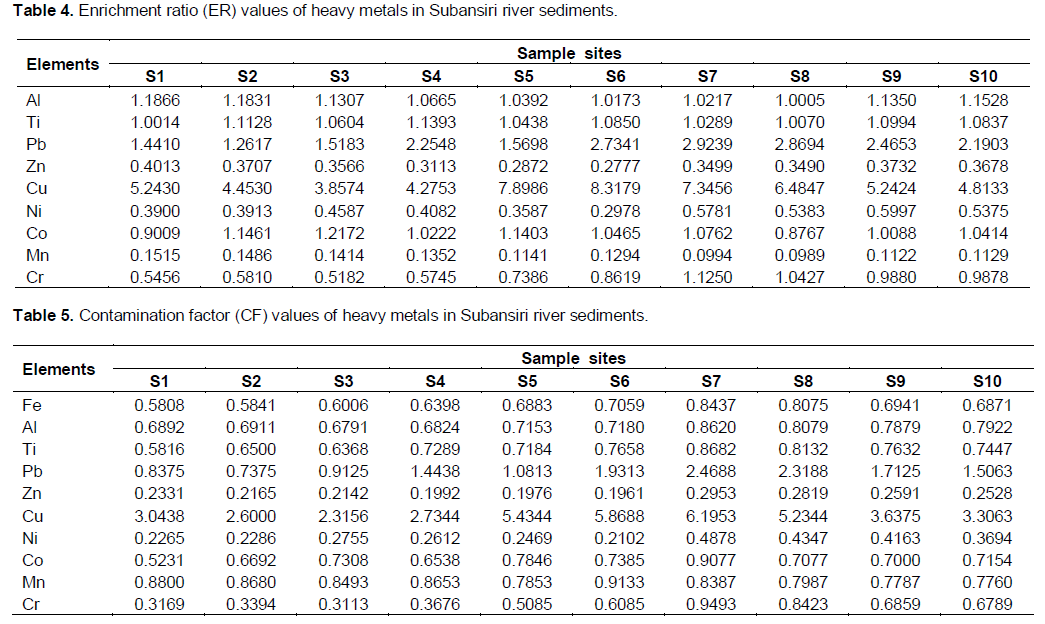
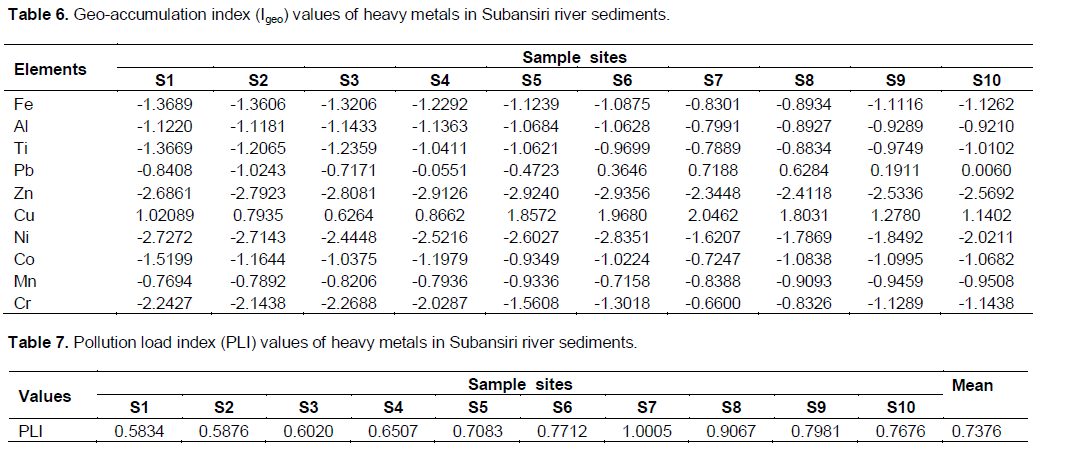
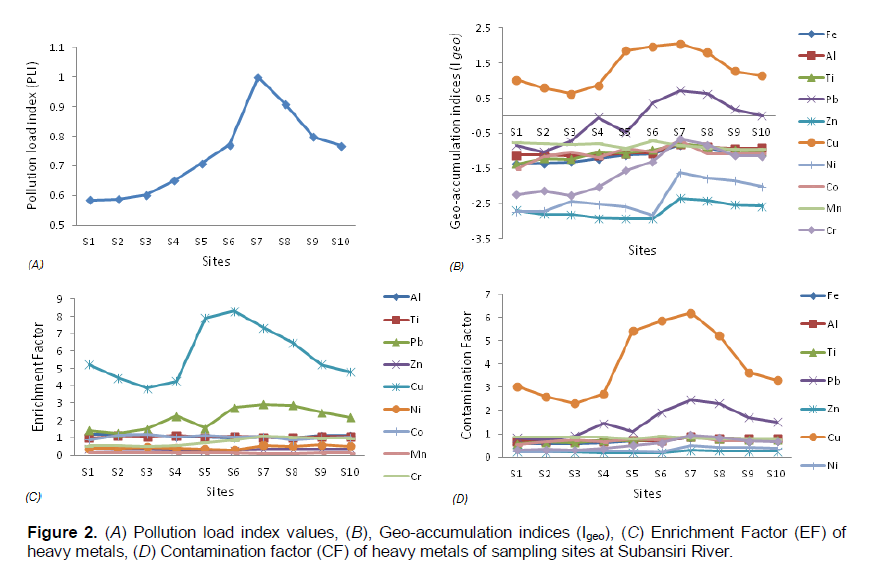
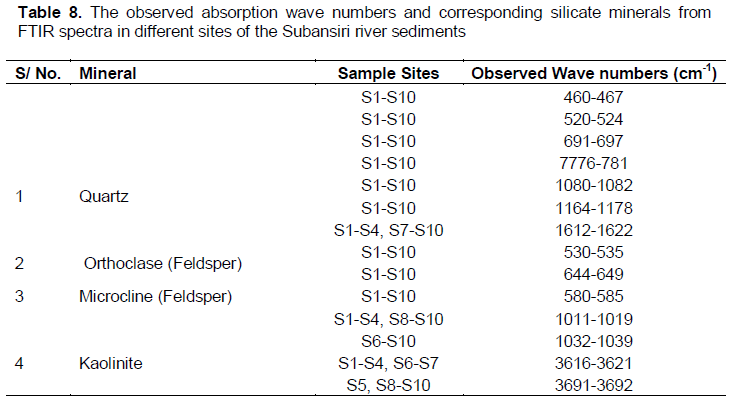
CONCLUSION
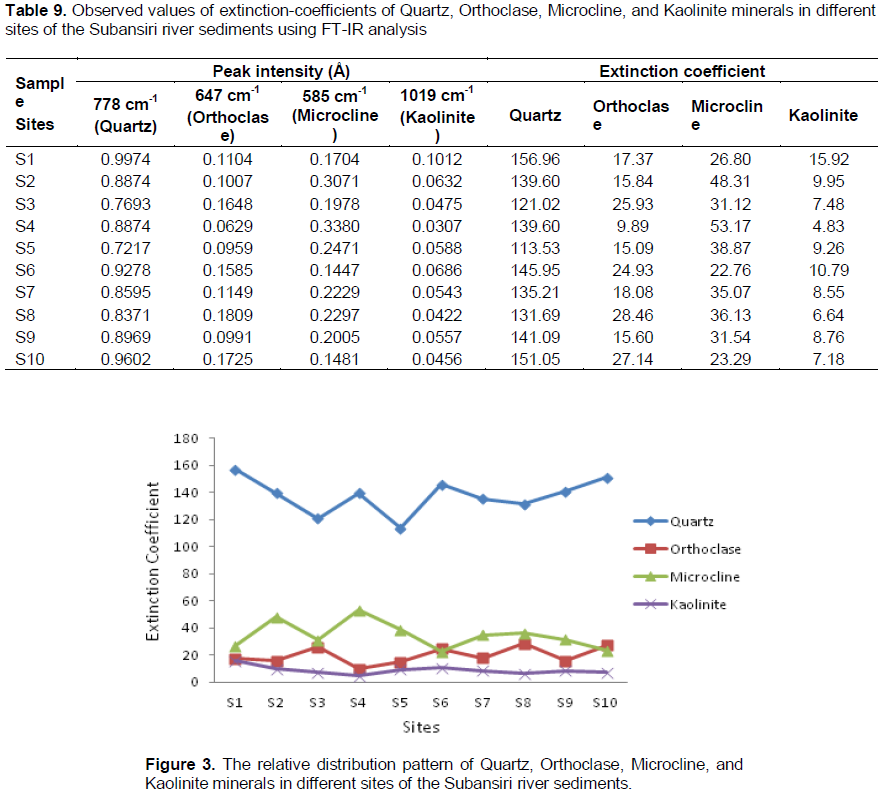
CONFLICT OF INTEREST
ACKNOWLEDGEMENTS
REFERENCES
|
Acevedo-Figueroa D (2006). Trace metals in sediments of two estuarine lagoons from Puerto Rico. Environ. Poll. 141(2):336-342. Crossref |
|
|
|
|
|
Akoto O, Ephraim JH, Darko G (2008). Heavy metals pollution in surface soils in the vicinity of abundant railway servicing workshop in Kumasi, Ghana. Int. J. Environ. Res. 2(4):359-364.
|
|
|
|
|
|
Alloway BJ, Ayres DC (1997). Chemical principles of environmental pollution, second edition, Blackie Academic and Professional, Chapman and Hall, London. pp. 208-211.
|
|
|
|
|
|
Biati A, Moattar F, Karbassi AR, Hassani AH (2010). Role of saline water in removal of heavy elements from industrial wastewaters. Int. J. Environ. Res. 4(1):177-182.
|
|
|
|
|
|
Borole DV, Sarin MM, Somayajulu BLK (1982). Composition of Narmada and Tapti Estuarine particles and adjacent Arabian sea sediments. Ind. J. Mar. Sci. 11:51-62.
|
|
|
|
|
|
Braun JJ, Descloîtres M, Riotte J, Fleury S, Barbiero L, Boeglin J, Violette A, Lacarce E, Ruiz L, Sekhar M, Kumar MSM, Subramanian S, Dupré B (2009). Regolith mass balance inferred from combined mineralogical, geochemical and geophysical studies: Mule Hole gneissic watershed, South India. Geochem. Cosmochim. Acta 73(4):935-961.
Crossref |
|
|
|
|
|
|
|
|
|
|
|
|
|
|
|
|
|
Chakrapani GJ, Subramanian V (1990). Preliminary studies on the geochemistry of the Mahanadi river basin, India. Chem. Geol. 70:247-266.
|
|
|
|
|
|
Chakravarty M, Patgiri AD (2009). Metal pollution assessment in sediments of the Dikrong River, N.E. India. J. Hum. Ecol. 27(1):63-67.
|
|
|
|
|
|
|
|
|
|
|
|
|
|
|
|
|
|
|
|
|
|
|
|
Dixit S, Tiwari S (2008). Impact assessment of heavy metal pollution of Shahpura Lake, Bhopal, India. Int. J. Environ. Res. 2(1):37-42.
|
|
|
|
|
|
Gadsden JA (1975). Infrared Spectra of Minerals and Related Inorganic compounds, Butterworths. USA. pp. 189-235.
|
|
|
|
|
|
|
|
|
|
|
|
|
|
|
|
|
|
GSI (1974). Geology and Mineral Resources of the States of India (Part IV–Arunachal Pradesh, Assam, Manipur, Mizoram, Nagaland and Tripura). Geol Sur of India Misc Pub No. 30, Kolkata: GSI.
|
|
|
|
|
|
GSI (1983). Proceedings of the symposium on geology and mineral resources of North Eastern Himalayas. Geol. Surv. India Misc Pub No. 43, Kolkata: GSI.
|
|
|
|
|
|
|
|
|
|
|
|
|
|
|
|
|
|
Hobbelen PHF, Koolhaas JE, van Gestel CAM (2004). Risk assessment of heavy metal pollution for detritivores in floodplain soils in the Biesbosch, The Netherlands, taking bioavailability into account. Environ. Poll. 129 (3):409-419. Crossref |
|
|
|
|
|
Karbassi AR, Monavari SM, Nabi Bidhendi Gh R, Nouri J, Nematpour K (2008). Metal pollution assessment of sediment and water in the Shur River. Environ. Monit. Assess. J. 147:107-116. Crossref |
|
|
|
|
|
Kashulin NA, Terentiev PM, Koroleva IM (2008). The status of whitefish population from Chuna Lake in the Lapland Biosphere Reserve Russia. Int. J. Environ. Res. 2(2):111-124.
|
|
|
|
|
|
Keller WD, Pickett EE (1949). Absorption of infrared radiation by powdered silica minerals. The American mineralogist. 34:855-868.
|
|
|
|
|
|
Kotoky P, Baruah J, Baruah NK, Sarma JN (1997). Geoenvironmental studies of the river Jhanji, Assam. J. Hum. Ecol. Special Issue No. 6: 55-67.
|
|
|
|
|
|
Koukal B, Dominik J, Vignati. D, Arpagaus P, Santiago S, Ouddane B, Benaabidate L (2004). Assessment of water quality and toxicity of polluted rivers Fez and Sebou in the region of Fez (Morocco). Environ. Poll. 131(1):163-172. Crossref |
|
|
|
|
|
|
|
|
|
|
|
Mensi Gh S, Moukha S, Creppy EE, Maaroufi K (2008). Metals accumulation in Marine Bivalves and Seawater from theLagoon of Boughrara in Tunisia (North Africa). Int. J. Environ. Res. 2(3):279-284.
|
|
|
|
|
|
Mmolawa K, Likuku A, Gaboutloeloe G (2011). Assess-ment of heavy metal pollution in soils along roadside areas in Botswana. Afr. J. Environ. Sci. Technol. 5(3):186-196.
|
|
|
|
|
|
|
|
|
|
|
|
Muller G (1969). Index of geoaccumulation in sediments of the Rhine River. J. Geol. 2:108-118.
|
|
|
|
|
|
Muller G (1981). The heavy metal pollution of the sediments of Neckars and Its Tributary, A Stock taking Chemische Zeit. 150:157-164.
|
|
|
|
|
|
Mumba PP, Chibambo BQ, Kadewa W (2008). A comparison of the levels of heavy metals in cabbages irrigated with reservoir and tap water. Int. J. Environ. Res. 2(1):61-64.
|
|
|
|
|
|
|
|
|
|
|
|
Nouri J, Mahvi AH, Bazrafshan E (2010). Application of electrocoagulation process in removal of zinc and copper from aqueous solutions by aluminum electrodes. Int. J. Environ. Res. 4(2):201-208.
|
|
|
|
|
|
Nriagu JO (1988). Production and uses of chromium, in: Nriagu JO, Niebner E (Eds.), Chromium in the natural and human environments. Wiley, New York, pp. 81-104.
|
|
|
|
|
|
|
|
|
|
|
|
Priju CP, Narayana AC (2007). Heavy and Trace Metals in Vembanad Lake Sediments. Int. J. Environ. Res. 1(4):280-289.
|
|
|
|
|
|
Ramasamy V, Murugesan S, Mullainathan S (2004). Characterization of minerals and relative distribution of quartz in Cauvery river sediments from Tamilnadu, India- A FTIR study. Bull. Pure Appl. Sci. 23(1-2):1.
|
|
|
|
|
|
Ramasamy V, Murugesan S, Mullainathan S (2005). Distribution and characterization of minerals in Cauvery river sediments by grain size analysis –A new approach by FTIR study. Ind. Miner. 39(2):91-93.
|
|
|
|
|
|
Ramasamy V, Rajkumar P, Ponnusamy V (2006). FTIR spectroscopic analysis and mineralogical characterization of Vellar river sediments. Bull. Pure Appl. Sci. 25(1):49-55.
|
|
|
|
|
|
|
|
|
|
|
|
|
|
|
|
|
|
|
|
|
|
|
|
Seralathan P (1987). Trace element geochemistry of modern deltaic sediments of the Cauvery river, east coast of India. Ind. J. Mar. Sci. 16:235-239.
|
|
|
|
|
|
Singh AK (1999). Elemental composition of the Damodar river sediments – A tributary of the Lower Ganga, India. J. Geol. Soc. India 53:219-231.
|
|
|
|
|
|
|
|
|
|
|
|
|
|
|
|
|
|
|
|
|
|
|
|
Subramanian V (1988). Environmental geochemistry of the Indian river basins: A review. J. Geol. Soc. India. 29:205-220.
|
|
|
|
|
|
|
|
|
|
|
|
|
|
|
|
|
|
|
|
|
|
|
|
Tomlinson D, Wilson J, Harris C, Jeffrey D (1980). Pro- blems in the Assessment of Heavy-Metal Levels in Estu-aries and the Formation of a Pollution Index. Helgoland Marine Res. 33(1-4):566-575.
|
|
|
|
|
|
Venugopal T, Giridharan L, Jayaprakash M (2009). Characterization and Risk Assessment Studies of Bed Sediments of River Adyar-An Application of Speciation Study. Int. J. Environ. Res. 3(4):581-598.
|
|
|
|
|
|
Ya ZG, Zhou LF, Bao ZY, Gao P, Sun XW (2007). High efficiency of heavy metal removal in mine water by limestone. Chin. J. Geochem. 28(3):293-298.
|
|
Copyright © 2024 Author(s) retain the copyright of this article.
This article is published under the terms of the Creative Commons Attribution License 4.0